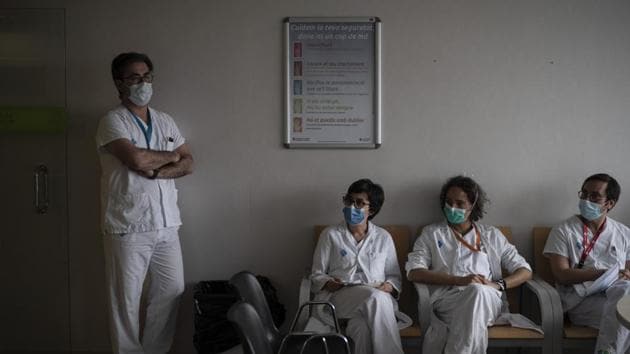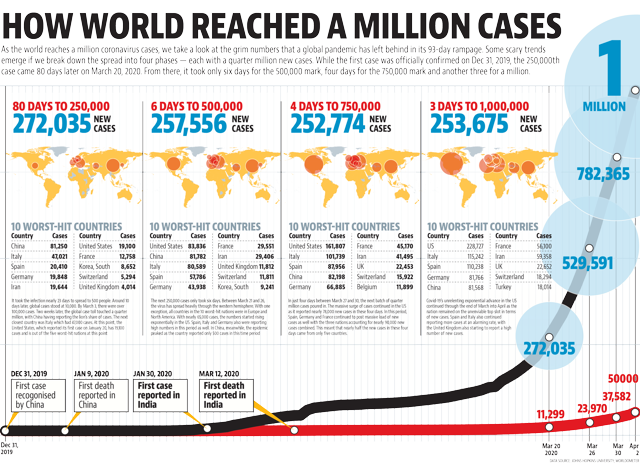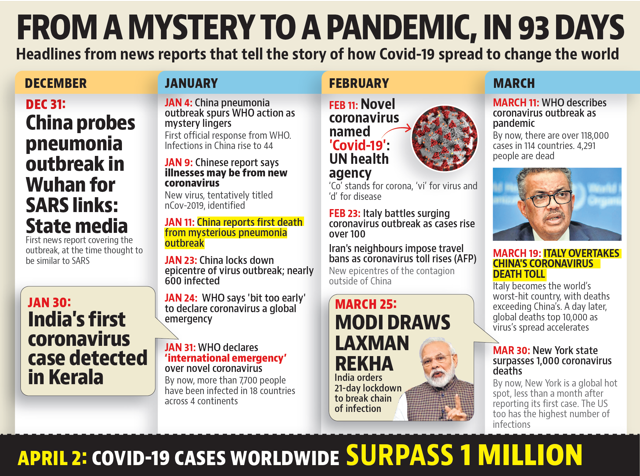Coronavirus: How world reached a million cases in 93 days
In less than 100 days in the new year – Thursday is the 93rd day to be precise – the coronavirus has infected 1 million people and killed 50,000, ripping through 203 countries.
At exactly 12pm IST on December 31, a 280-word report from news agency AFP made its way to newsrooms around the world. Citing local media, the report said a mystery virus was causing “viral pneumonia of unknown origin” in the city of Wuhan, where 27 people had been infected till then. The story drew little attention, as the world prepared to celebrate the beginning of a new year later that night.

In less than 100 days in the new year – Thursday is the 93rd day to be precise – the virus has infected 1 million people and killed 50,000, ripping through 203 countries in a rampage that will likely exact as severe an economic, social and psychological toll as the number of casualties by the time humanity can beat it. Till now, a little over 200,000 have recovered from the disease.
Click here for the complete coverage of the Covid-19 pandemic
In India, infections crossed 2,000 on Wednesday and the country was on course to add 514 more on Thursday -- the first time daily new cases crossed the 500 mark. New fatalities too logged a big jump -- 19 -- taking the total toll to 72 in the country, which is in the middle of a three-week long nationwide shutdown to ensure the coronavirus disease (Covid-19) outbreak does not assume the proportions it has in countries such as Italy and the United States.

The United States is now the worst-hit region, accounting for more than a third of all daily new cases around the world. New York has lost 2,200 people and the virus was on course to surpass the 9/11 terror attacks in the next 36 hours as the deadliest tragedy in a city that is at the heart of modern day pop culture.
Almost 10 million Americans filed for unemployment benefits in the last two weeks.
The United States and Europe are largely being regarded as the current hot spots of the pandemic, with world leaders expecting “the roughest two or three weeks” in their country. “We’re going to lose thousands of people,” US President Donald Trump said earlier in the week, while projecting that up to 240,000 people could die.
Italy, with a large ageing population that is the most vulnerable to the Sars-Cov-2 pathogen, has seen the highest number of deaths at 13,000. Spain, the United Kingdom, France and Germany together account for close to 20,000 fatalities.
China, where the pathogen is believed to have mutated in either bats or pangolins to jump to humans, has recorded 3,300 deaths – with a rate of growth that slowed into single digits only after what has been a close two months of lockdown in large parts of the country.

Stock markets around the world suffered historic losses in the first three months of the year. The Dow Jones Industrial Average and London’s FTSE 100 saw their biggest quarterly drops since 1987, plunging 23% and 25% respectively.
In India, Bombay Stock Exchange investors lost around Rs 33.38 lakh crore (in market value) in March, the month when the coronavirus contagion spread to equities.
In an age largely defined as the era of social media, Covid-19 has now introduced a new zeitgeist: social distancing. Jobs that can be done are now being done from home -- as are classes for schools and college, and even the UK parliament. As a result, digital pipelines are sagging under the load of unprecedented video streaming and conferencing.
Also Read: Genetic sequencing takes lead in Covid-19 vaccine development
In India, authorities have now begun preparations to deal with what may be an inevitable surge in infections, and chart out strategies to allow at least some people to resume work when the lockdown ends on April 15.
“It is important to formulate a common exit strategy to ensure staggered re-emergence of the population once the lockdown ends,” Prime Minister Narendra Modi told chief ministers on Thursday, asking states to send their suggestions for such an exit strategy.
“It can’t be business as usual,” a government release quoted the PM as saying, perhaps summing up the reality the rest of the world will need to confront – at least for the next 12-18 months by when a viable, mass-produced vaccine is expected to be a reality.
Research labs and pharmaceutical companies in the US, China and European nations are working at full tilt to develop a vaccine that can fight stem the pandemic.
Trials have begun in China, United States and Germany with first participants taking shots of the first vaccine candidates.
A drug used in the treatment of malaria has also held out hope, and prompted India to prescribe it as a prophylactic for medical staff dealing with the cases. Hydroxychloroquine when paired with azithromycin (an antibiotic) has been shown to clear patients of the virus at a much faster rate than seen usually.
Get Current Updates on India News, Lok Sabha Election 2024 live, Infosys Q4 Results Live, Elections 2024, Election 2024 Date along with Latest News and Top Headlines from India and around the world.



